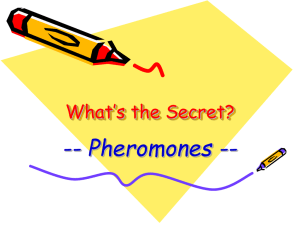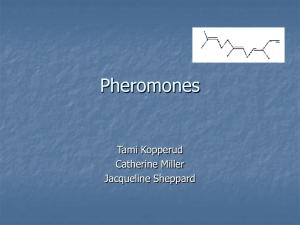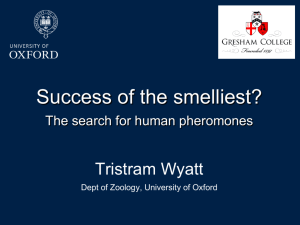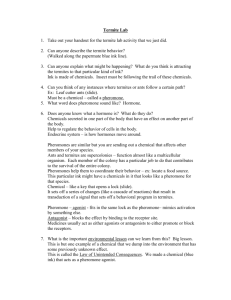Sex pheromones in amphibians: a review J. RAJCHARD
advertisement
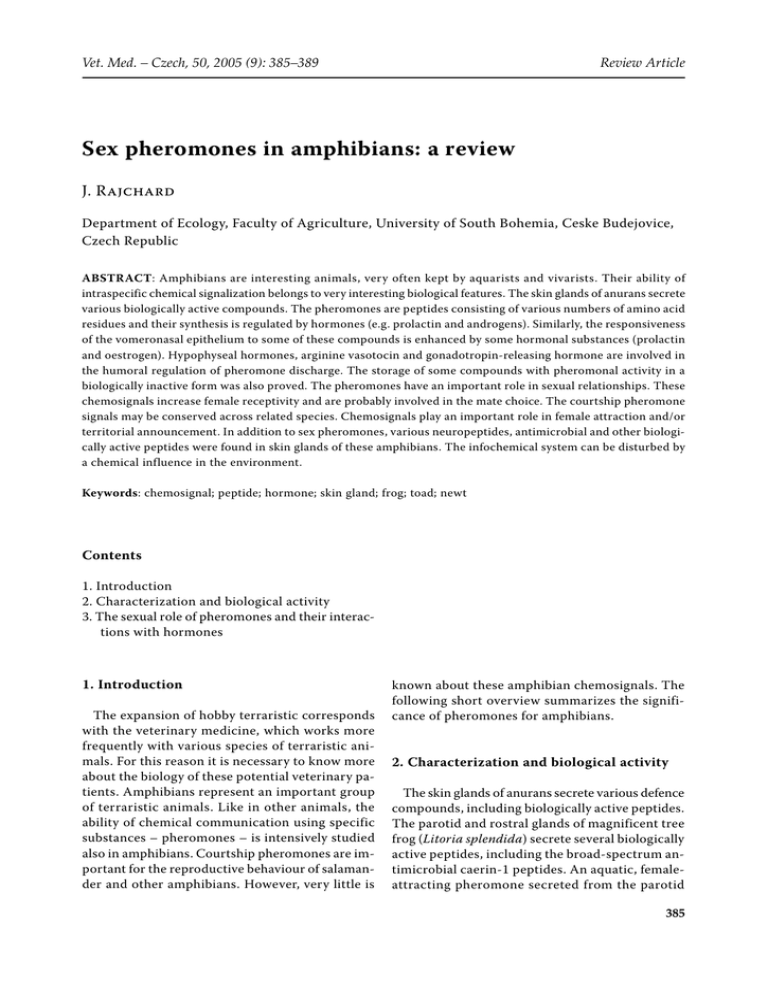
Vet. Med. – Czech, 50, 2005 (9): 385–389 Review Article Sex pheromones in amphibians: a review J. RAJCHARD Department of Ecology, Faculty of Agriculture, University of South Bohemia, Ceske Budejovice, Czech Republic ABSTRACT: Amphibians are interesting animals, very often kept by aquarists and vivarists. Their ability of intraspecific chemical signalization belongs to very interesting biological features. The skin glands of anurans secrete various biologically active compounds. The pheromones are peptides consisting of various numbers of amino acid residues and their synthesis is regulated by hormones (e.g. prolactin and androgens). Similarly, the responsiveness of the vomeronasal epithelium to some of these compounds is enhanced by some hormonal substances (prolactin and oestrogen). Hypophyseal hormones, arginine vasotocin and gonadotropin-releasing hormone are involved in the humoral regulation of pheromone discharge. The storage of some compounds with pheromonal activity in a biologically inactive form was also proved. The pheromones have an important role in sexual relationships. These chemosignals increase female receptivity and are probably involved in the mate choice. The courtship pheromone signals may be conserved across related species. Chemosignals play an important role in female attraction and/or territorial announcement. In addition to sex pheromones, various neuropeptides, antimicrobial and other biologically active peptides were found in skin glands of these amphibians. The infochemical system can be disturbed by a chemical influence in the environment. Keywords: chemosignal; peptide; hormone; skin gland; frog; toad; newt Contents 1. Introduction 2. Characterization and biological activity 3. The sexual role of pheromones and their interactions with hormones 1. Introduction The expansion of hobby terraristic corresponds with the veterinary medicine, which works more frequently with various species of terraristic animals. For this reason it is necessary to know more about the biology of these potential veterinary patients. Amphibians represent an important group of terraristic animals. Like in other animals, the ability of chemical communication using specific substances – pheromones – is intensively studied also in amphibians. Courtship pheromones are important for the reproductive behaviour of salamander and other amphibians. However, very little is known about these amphibian chemosignals. The following short overview summarizes the significance of pheromones for amphibians. 2. Characterization and biological activity The skin glands of anurans secrete various defence compounds, including biologically active peptides. The parotid and rostral glands of magnificent tree frog (Litoria splendida) secrete several biologically active peptides, including the broad-spectrum antimicrobial caerin-1 peptides. An aquatic, femaleattracting pheromone secreted from the parotid 385 Review Article and rostral glands of this frog species was the first pheromone from an anuran (frogs and toads) to be identified. This substance was designated splendipherin (Wabnitz et al., 1999). Female-attracting pheromones obtained from the abdominal gland of Japanese fire bellied newt (red bellied newt, Cynops pyrrhogaster) and Japanese sword-tail newt (Cynops ensicauda) males are peptides consisting of 10 amino acid residues. Both of them are generated from precursor proteins. These substances were designated sodefrin and silefrin, respectively, and each attracted only conspecific females. The synthesis of these pheromones is regulated by the hormones prolactin (PRL) and androgen. The responsiveness of the vomeronasal epithelium to sodefrin is enhanced by prolactin and oestrogen. Every salamander synthesizes multiple isoforms of the specific pheromone, which was designated Plethodontid receptivity factor. An example is a 22-kD proteinaceous pheromone, secreted in the submandibular gland of terrestrial salamander Plethodon jordani males. In Anura, the female-attracting peptide pheromone, splendipherin, was investigated in magnificent tree frog (Litoria splendida). This chemosignal comprises 25 amino acid residues and is secreted in the male skin glands (Kikuyama et al., 2002). A decapeptide – sodefrin with a species specific activity was found in the apical portion of epithelial cells of the abdominal gland of the male of Cynops pyrrhogaster. This is considered to be the first peptide pheromone identified in a vertebrate (Kikuyama et al., 1995). The pheromone sodefrin of Cynops pyrrhogaster males is stored in a biologically inactive COOH-terminally extended form. The activation of a protease that cleaves at a Lys-Ile bond and thus produces the active pheromone must occur by the time of the onset of reproductive behaviour. Additional peptides [preprosodefrin-(146-175)-peptide and preprosodefrin-(159-173)-peptide] are derived from the precursors by cleavage at monobasic and dibasic processing sites. The existence of multiple genes encoding sodefrin and its variants was confirmed (Iwata et al., 2004). The pheromone detection is mediated through neurons of the vomeronasal organ. Possible pheromone receptors include two groups of the G-protein coupled with seven transmembrane proteins (Yamagishi et al., 2002). Various animals release biogenic substances that vary in composition with the physiological state. 386 Vet. Med. – Czech, 50, 2005 (9): 385–389 A high-density population might produce chemical messages that cause a reduction of productive processes (e.g. growth, metamorphosis and reproduction) in conspecific or related individuals, or even illness and death (loss of immunocompetence, anaphylaxis). The infochemical system can be disrupted by an ecological influence (chemical contamination of aquatic ecosystems) (Kamps and Neill, 1999). 3. The sexual role of pheromones and their interactions with hormones The pheromones have an important role in sexual relationships. Males of salamanders of the family Plethodontidae deliver special pheromones during courtship interactions. The role of pheromones in the courtship behaviour of the North American southern dusky salamander, Desmognathus fuscus conanti (Plethodontidae), was described by Verrell (1995). The pheromones are secreted from the male’s mental (chin) gland. These chemosignals increase female receptivity and are probably involved in the mate choice. Rollmann et al. (2003) investigated if conspecific and heterospecific pheromones acted in some salamander species. Females of Plethodon shermani were exposed to conspecific (P. shermani) or heterospecific (P. yonahlossee or P. montanus) male pheromones. In all cases, the exposure to pheromones increased female receptivity, indicating that pheromones from the heterospecific species were as effective as the conspecific pheromones. These courtship pheromone signals may be conserved across related species. Male courtship pheromones of terrestrial salamanders are received by the accessory olfactory system and act (presumably via the hypothalamus) to increase female receptivity and thus they can increase male courtship success (Houck, 1998). The cutaneous glands were studied in some species of Rana (R. dalmatina, R. iberica, R. italica, R. “esculenta”, R. perezi). Two different types of mucous cutaneous glands were found in R. dalmatina, R. iberica, and R. italica. Besides the ordinary mucous units, randomly distributed over the body surface in both males and females, specialized mucous glands were observed on the male dorsal skin, but they are present only in males of R. dalmatina, R. iberica, and R. italica. In males of these species with specialized skin glands vocal sacs did not oc- Vet. Med. – Czech, 50, 2005 (9): 385–389 cur. Chemosignals released by the male mucous units of the three above-mentioned species may replace vocal communication during the breeding season and thus play an important role in female attraction and/or territorial announcement (Brizzi et al., 2002). An interesting influence of a neurohypophyseal hormone, arginine vasotocin (AVT), was found in experiments with the males of the newt Cynops pyrrhogaster. AVT enhanced the incidence and frequency of androgen-induced courtship behaviour. In this case, AVT was likely to act centrally because the behaviour was evoked with a much smaller amount of AVT when the hormone was administered intracerebroventricularly than when given intraperitoneally. This indicates that AVT induces sodefrin discharge, acting peripherally on the contractile structure of the abdominal gland: the content of sodefrin, a female-attracting pheromone in the abdominal gland, was decreased by the intraperitoneal AVT application, suggesting that AVT stimulated the release of sodefrin from the abdominal gland into water. AVT was also found to induce spermatophore deposition in the male kept in the absence of the female. The results of these experiments indicate the involvement of AVT in reproductive natural events, acting both centrally and peripherally (Toyoda et al., 2003). The effects of AVT and gonadotropin-releasing hormone (GnRH) were investigated in two different types of sexual behaviour, calling and amplexus, in the Great Plains toad (Bufo cognatus). The former of these two peptides, AVT, applied at a dosage of 100 µg/100 g animal weight, significantly increased both the amount of calling behaviour per individual and the probability that an individual would call, but it did not induce amplexus. GnRH had no effect on calling behaviour, but significantly induced amplexus. There was a reciprocal effect of these peptides on amplexus. These results are the first report of GnRH influencing sexual behaviour in an anuran amphibian. AVT effect could be inhibited by Manning compound (an arginine vasopressin receptor antagonist) (Propper and Dixon, 1997). Vasotocin (AVT) and its mammalian homologue vasopressin influence various social behaviour. In male roughskin newts, Taricha granulosa, AVT stimulates courtship behaviour and amplectic clasping. AVT affects male courtship behaviour by enhancing the central state of sexual motivation, by affecting sensorimotor integration mechanisms in individual sensory modalities, or by influencing Review Article a nonspecific state of attention, arousal, or anxiety. AVT selectively enhanced responses to female olfactory stimuli (sex pheromones), but similarly enhanced responses to female and food-related visual stimuli (worms). The utility of such a motivational mechanism was thus questioned, as the responses to female stimuli were not selectively enhanced in all sensory modalities. It is probable that exogenous AVT independently influences olfactory processes associated with orientation/attraction toward a female sex pheromone and visual processes associated with orientation/attraction toward a visual feature common to females and worms. The results suggest that AVT affects courtship by influencing specific sensorimotor processes associated with behavioural responses to individual releasing stimuli (Thompson and Moore, 2000). The influence of courtship on plasma steroid and brain gonadotropin-releasing hormone (GnRH) concentrations was studied in the newt Taricha granulosa with respect to changes in female sexual receptivity. GnRH levels were high in the anterior telencephalon at courtship initiation (females unreceptive), but decreased by sperm transfer (females receptive). No effect of courtship on GnRH concentrations in any other brain region or on plasma progesterone or corticosterone levels was found (Propper and Moore, 1991). The sexually dimorphic skin glands (breeding glands) of male dwarf African clawed frogs (Hymenochirus sp.) release a mate-attractant chemosignal. Conspecific females showed a positive chemotaxis to water housing males and to water containing homogenized breeding glands, but they showed no reaction to water housing conspecific females or to water housing breeding gland-ablated males. Males of Hymenochirus showed no response to water housing either females or other males, indicating that the attractant is specific to females. Because many anuran species possess breeding glands, pheromonal communication may be more widespread among frogs and toads (Pearl et al. 2000). One of two minor peptides of the male Litoria splendida skin secretions is the female-attracting aquatic male sex pheromone, a 25 amino acid peptide, called splendipherin. This pheromone constitutes about 1% of the total skin peptides during the breeding season (January to March), but about 0.1% during the period June to November. Splendipherin attracts conspecific females. The second peptide is a wide-spectrum antibiotic of the caerin 1 group (called caerin 1.10), a 25-residue peptide. The 387 Review Article neuropeptides of L. splendida are also seasonally variable, the change is identical for both females and males. During the period October to March, only the neuropeptide caerulein is secreted in skin. Caerulein is active on smooth muscles and is also an analgesic. During the southern winter (June to September), more than half of the caerulein is hydrolysed, and this substance shows no smooth muscle activity. A new peptide, Phe8 caerulein, becomes a major component of the skin secretion. Perhaps this seasonal change is involved in thermoregulation, which initiates and maintains frog hibernation (Wabnitz et al., 2000). The chemical communication in the archaic anura Leiopelma hamiltoni was investigated by Waldman and Bishop (2004). This investigation offers an insight into how frogs may have communicated before mechanisms of bioacoustic signalling evolved. The experimental animals preferred substrates that they had marked themselves to those marked by frogs collected from other home ranges. The preferences were greater when the conspecific frogs had been collected farther away. The animals did not discriminate between their own odour and those of other individuals with which they had shared a home range. The knowledge of peptides isolated from Australian anurans was summarized by Apponyi (2004). In addition to sex pheromones, various neuropeptides (including smooth muscle active peptides and peptides that inhibit the production of nitric oxide from neuronal nitric oxide synthase), antimicrobial and anticancer active peptides, antifungal peptides and antimalarial peptides were found in skin glands of these animals. Acknowledgement The author wishes to thank Dr. Hanka Cizkova for critical English revision of the manuscript. REFERENCES Brizzi R., Delfino G., Pellegrini R. (2002): Specialized mucous glands and their possible adaptive role in the males of some species of Rana (Amphibia, Anura). Journal of Morphology, 254, 328–341. Houck L.D. (1998): Integrative studies of amphibians: From molecules to mating. American Zoologist, 38, 108–117. 388 Vet. Med. – Czech, 50, 2005 (9): 385–389 Iwata T., Conlon J.M., Nakada T., Toyoda F., Yamamoto K., Kikuyama S. (2004): Processing of multiple forms of preprosodefrin in the abdominal gland of the redbellied newt Cynops pyrrhogaster: regional and individual differences in preprosodefrin gene expression. Peptides, 25, 1537–1543. Kamps R.H., Neill W.H. (1999): Aquacultural effluents: Directive signals to the system downstream? Journal of Chemical Ecology, 25, 2041–2050. Kikuyama S., Toyoda F., Ohmiya Y., Matsuda K., Tanaka S., Hayashi H. (1995): Sodefrin: A female-attracting peptide pheromone in newt cloacal glands. Science, 267, 1643–1645. Kikuyama S., Yamamoto K., Iwata T., Toyoda F. (2002): Peptide and protein pheromones in amphibians. Comparative Biochemistry and Physiology, 132, 69–74. Pearl C.A., Cervantes M., Chan M., Ho U., Shoji R., Thomas E.O. (2000): Evidence for a mate-attracting chemosignal in the dwarf African clawed frog Hymenochirus. Hormones and Behavior, 38, 67–74. Propper C.R., Dixon T.B. (1997): Differential effects of arginine vasotocin and gonadotropin-releasing hormone on sexual behaviours in an anuran amphibian. Hormones and Behavior, 32, 99–104. Propper C.R., Moore F.L. (1991): Effects of courtship on brain gonadotropin hormone-releasing hormone and plasma steroid concentrations in a female amphibian (Taricha granulosa). General and Comparative Endocrinology, 81, 304–312. Rollmann S.M., Houck L.D., Feldhoff R.C. (2003): Conspecific and heterospecific pheromone effects on female receptivity. Animal Behaviour, 66, 857–861. Thompson R.R., Moore F.L. (2000): Vasotocin stimulates appetitive responses to the visual and pheromonal stimuli used by male roughskin newts during courtship. Hormones and Behavior, 38, 75–85. Toyoda F., Yamamoto K., Ito Y., Tanaka S., Yamashita M., Kikuyama S. (2003): Involvement of arginine vasotocin in reproductive events in the male newt Cynops pyrrhogaster. Hormones and Behavior, 44, 346–353. Verrell P.A. (1995): The courtship behaviour of the spotted dusky salamander, Desmognathus fuscus conanti (Amphibia: Caudata: Plethodontidae). Journal of Zoology, 235, 515–523. Wabnitz P.A., Bowie J.H., Tyler M.J., Wallace J.C., Smith B.P. (1999): Aquatic sex pheromone from a male tree frog. Nature, 401, 444–445. Wabnitz P.A., Bowie J.H., Tyler M.J., Wallace J.C., Smith B.P. (2000): Differences in the skin peptides of the male and female Australian tree frog Litoria splendida – The discovery of the aquatic male sex pheromone splendipherin, together with Phe8 caerulein and a new an- Vet. Med. – Czech, 50, 2005 (9): 385–389 tibiotic peptide caerin 1.10. European Journal of Biochemistry, 267, 269–275. Yamagishi K., Isobe N., Moriya K., Wakabayashi Y., Ichikawa M., Yazaki K. (2002): Expression of the Review Article vomeronasal receptor genes in Xenopus laevis. Zoological Science, 19, 1467. Received: 05–07–13 Accepted: 05–09–09 Corresponding Author RNDr. Ing. Josef Rajchard, PhD., University of South Bohemia, Faculty of Agriculture, Department of Ecology, Studentska 13, 370 05 Ceske Budejovice, Czech Republic Tel. +420 387 772 757, e-mail: rajchard@zf.jcu.cz 389
